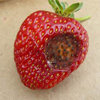A high-performance, natural solution for strawberry crop improvement
BVT’s comprehensive, stackable system uses commercially-reared bees to deliver highly targeted pest and disease control without harmful chemicals.
Increase your crop yield
Experience 30% or more fruit yield in strawberries per acre
Reduce fungicide usage
Reduce (or even eliminate) the number of fungicide sprays applied
Grow healthier plants
Plants achieve a higher vigor rating than fungicide treated crops
Extend shelf life
Provide a longer lasting crop that offers more economic value to retailers
Common diseases and pests affecting strawberries
Strawberries are susceptible to a number of common diseases and pests that can wreak havoc on plant health, berry yield and ultimately shelf life from farm to plate. The BVT system has been specifically engineered to target these fungal diseases and pests, dramatically improving crops all season long.
What is it?
Botrytis cinerea (or grey mold) is widely familiar as greyish fuzzy mold growth on ripening or ripened berries and is destructive in strawberries worldwide. Botrytis fruit rot can appear in the field, greenhouse or hoop house, but develops chiefly after picking, during marketing and in the home.
How does it enter the plant?
Botrytis invades the foliage of strawberry crops and appears as fuzzy grey mold on the leaves as they yellow and turn brown. The disease spreads in the crop by means of spores dispersed from the fuzzy growth. Spores readily infect the blossoms, which may become blighted, and spread from the blossoms into the developing fruit. Fruit rot appears primarily on ripening berries or after they have been picked.
Where does it come from?
Botrytis is prevalent in crops and vegetation in most strawberry growing areas worldwide. Botrytis is commonly present in strawberry transplants.
Additional Resources
- BVT Video: How Botrytis infects a plant
- BVT Info: Clonostachys as a biological control for Botrytis
- Cornell University Time Lapse Video of the Disease on Strawberries
- PennState Extension
What is it?
Affected berries rapidly soften and collapse and become covered with whiskery fungal growth bearing minute black capsules at the whisker tips. Red juices leak from the berries. Some people simply call the disease “leak”.
How does it enter the plant?
Rhizopus infects the berries via minute wounds. It is frequently associated with botrytis and other fruit diseases.
Where does it come from?
Rhizopus occurs widely in vegetation and soils.
Additional Resources
What is it?
Anthracnose is a highly destructive fungal disease of strawberry flower buds, open flowers and fruit. Affected flowers quickly die and dry out. Fruit are very susceptible when ripening and continue to rot as they mature. Anthracnose fruit rot becomes firm, looks dark brown to black, and may affect the entire fruit.
How does the disease enter the plant?
Rainy conditions readily disperse anthracnose spores from infected strawberry plants and plant residues to highly susceptible flowers and fruit. The dispersed spores infect the flowers and fruit as they develop. Spread of anthracnose is extremely limited under dry and cool conditions.
Where does it comes from?
Infected transplants are a principal source of anthracnose in annual production fields. In strawberries grown as perennial crops, anthracnose fungi overwintering in the crop and crop residues can initiate disease in the following crop season. Young runners and the youngest leaves are highly susceptible to infection but during the fruiting period the foliage and crowns are highly resistant.
Additional Resources
What is it?
Mites are considered second only to Botrytis as an economic pest issue in strawberries. Spider mites are yellowish to dark crimson and range up to 0.5 mm long. They can just be seen with the naked eye. Spider mites frequently move around busily, especially on the undersides of the leaves. Feeding by mites gives the leaves a stippled or mottled appearance at first but later the leaves may look bronzed and dry out. They can also cause bronzing of the berries. Mites have four pairs of legs compared to three for insects.
How does it enter the plant?
Spider mites feed and lay eggs on the lower surfaces of leaves, where silk like webs develop when infestations are heavy. Mite-affected leaves and blossoms tend to dry out. Even minor mite infestations can predispose strawberry plants to pathogen invasion and buildup, especially Botrytis.
Where does it come from?
Mites are extremely common pests of field crops, orchard fruits and ornamental plants worldwide. They are easily dispersed to field grown strawberries; mites can enter greenhouses on plant materials and through openings such as air vents and open doors.
Additional Resources
The natural way to improve yields
BVT’s easy-to-use tray system introduces natural organic compounds to strawberry plants using commercially-reared bees.
As the bees pollinate a crop, they leave behind the foundation for a season-long pest and disease management program that encourages even and progressive growth, resulting in a healthy, high yield harvest.

The BVT dispenser system contains the inoculant crop control as a part of the Vectorpak™ tray with Vectorite™ powder. The mixture allows the bees to effectively pick up the product on their way out of the hive.
Reduce your chemical materials by 99.5%
Over a 2.5 month strawberry season,* BVT uses 0.02 kg of biologicals versus 4 kg of chemical pesticides in a traditional spraying program. That’s a 99.5% decrease in the amount of material used!

* Amount of BVT CR-7 used in 2 hives per acre with Vectorite with CR-7 trays replaced every 5 days vs. 10 sprays of Switch fungicide at rate of 14 oz/ac.
Eliminate traditional spraying
Spraying of fungicides is the most commonly used method for combating disease in a strawberry crop. Because many diseases do not exhibit symptoms until it is too late, spraying is used preventatively across an entire crop. Fungicide spraying is usually done at intervals over a calendar period, prohibiting consistent crop progression since each spray cycle stunts plant growth.
Start your demonstration today!
Contact one of our representatives to setup an on-site demonstration of the BVT system to experience the improvement it can have on your crop yield.










